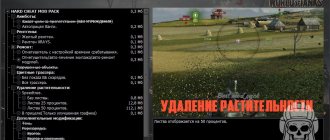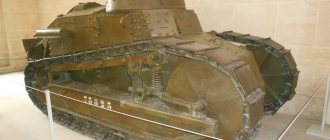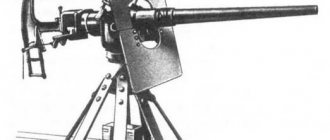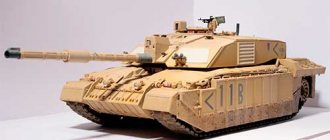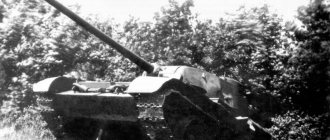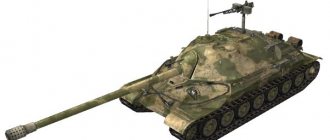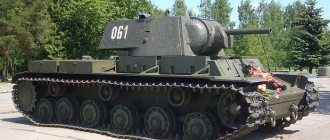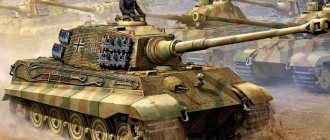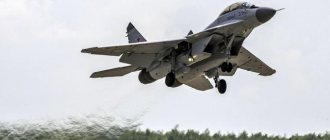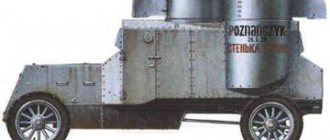“Porokhovshchikov’s real tank”
One of the most famous photos, which has circulated in almost all publications of the Soviet era...
Tanks of alternative history.
In Soviet times, namely since 1949, it was generally accepted that the birthday of the tank in Russia was May 18, 1915, when testing of the “A. Porokhovshchikov tank” “All-terrain vehicle” began. They wrote that he passed the tests successfully. And that the inventor and his like-minded people were ready to “bring” the machine to perfection and even “teach” it to swim. But the inertia of the tsarist military became the reason that Porokhovshchikov’s project did not receive support, and was ruined in the bud due to the “admiration of noble officers for the West.”
Since both the photographs of this machine and its drawings (from the Tekhnika-Molodezhi magazine) are well known to everyone today, there is no point in citing them. Although it should be remembered that the all-terrain vehicle had only one caterpillar track, first canvas, then rubber, that it was driven by wheels and that it would simply be impossible to make its body airtight due to the design features. The turret with the Maxim machine gun was added to it later, apparently forgetting that it could only be fired with two hands, and then two more hands would have been required to control this machine. So it would be impossible to lead it alone and, in addition, to shoot.
The All-Terrain Vehicle would not have been able to tear through the wire fences. The reasons are simple: the mass was small, its dimensions were tiny, and the caterpillar itself did not inspire confidence. That is, we have before us an all-terrain vehicle, and a poorly designed one at that, and it is not at all surprising that it was rejected!
Moreover, the fact that this is a “tank” was later written by almost the same people as the authors of the 1943 tank design textbook, which said:
“A tank is a combat vehicle that combines armor protection, fire and maneuver.”
By the way, there was no armor on the “All-terrain vehicle” either, although Porokhovshchikov offered it and even tested it on... a wheeled vehicle.
So not every experimental vehicle on one or two tracks is a tank! For example, the British built a scaled-down model of the Hetterington “cruiser” from wood, saw what was what, weighed the pros and cons, and... They abandoned the construction of a large car in June 1915.
Also in July 1915, engineer Colonel Evelen Bell Crompton presented a design for a composite, four-track tank with four turrets mounted linearly and elevated, like the turrets of a warship. The “Landships Committee” rejected it too. And then he rejected the developments of the Canadian engineer Robert Francis McPhie. But the very first design of his car also included a propeller, that is, it was conceived as floating! He was also on his other project. It was supposed to be lowered if necessary, and to be raised to protect it from damage when hitting the ground. Moreover, they were offered a tracked chassis made of tracks arranged in the shape of a triangle: one in front and two on the left and right behind.
This is what Canadian Francis McPhie's tank might have looked like if it had been built. Perhaps then the entire world tank building would have taken a completely different path!
The front caterpillar played the role of a steering track, that is, it could turn to the sides and also change its position in the vertical plane. McFay's second "tank" was designed to have four tracks, with the front two being located one behind the other. The front track was supposed to make it easier to overcome the vertical obstacles encountered, and the rest were supposed to reduce the pressure of this heavy machine on the ground.
Armament could be installed both in the hull itself and in the sponsons on the sides of it. But the military found its design too complicated. But he could have made an interesting tank, probably no worse than the serial Mk. I, and all the other tanks that followed it.
The same British at first considered tanks as some kind of ships, and even called them “land fleet.” And since there is a “fleet” and there are “tanks - machine gun fighters” (analogous to destroyers), then they should also have their own ... “flotilla leader”, leading them to attack the enemy. There was a project, but it never appeared in metal!
It is interesting that after Porokhovshchikov was shot, all his papers disappeared in the KGB archives, and what was in them is still unknown today. But one more of his projects survived, fortunately, surviving in the documents of the State Technical University from August of the same 1915, which he called “Earthly Battleship”. Moreover, he proposed two vehicles at once: a “field battleship” and a “serf”.
"Ideas are in the air." There was a project for the “Mendeleev tank”, and there was a project by Canadian engineer Stephen Kupchak. True, its armor was thinner, and its gun was only 75 mm in caliber
Well, he ended up with a very interesting project, although it was completely unrealizable. Even the Tsar Tank, by the way, gives in to him. And if some German had come up with this, one can only imagine how he would have been ridiculed in our press for being a “gloomy Teutonic genius.”
Well, we will begin to consider it by pointing out: the armor of a field battleship, in the author’s opinion, should have had a thickness capable of withstanding hits from field artillery shells, and the second from fortress artillery. Therefore, it was assumed to be thick... 101.6 mm!
“Navrotsky Tank” (“Improved Turtle”) - a project by engineer S. Navrotsky, proposed in April 1917. Weight – 192 tons. Height – 8.52 m. Length – 11.72 m. Width – 8.52 m. Engine – 150 l. With. Armament: two 203 mm howitzers, two 152 mm guns, four 102 mm and eight machine guns. Reservation – 20–30 mm. Crew – 60 people
However, what else could you expect from a car that looked simply monstrous? She did not have a body as such. It was replaced by a steel riveted truss 35 meters long and 3 m wide, to which 10 motor wheels, shaped like rollers with a diameter of 2.3 m each, were to be attached. Naturally, made of armor steel. Gasoline engines with a capacity of 160–200 hp were located directly in the rollers. s., and the transmission and fuel tank were also located there. The total power of the propulsion system would thus be 2000 hp. With.
And our “talented” designer also put three people there: a mechanic servicing the engine, and two gunners who were supposed to shoot from two machine guns and... a bomb thrower. That is, the “battleship” was supposed to have 20 machine guns and 10 bomb launchers on each side.
But all this seemed not enough to Porokhovshchikov. And he also installed two armored turrets on his “battleship”, armed with two guns: one 4–6 inch (101.6–152.4 mm) gun and a twin gun of a reduced caliber – 47–75 mm. The armored cabin of the commander of the “battleship” and all his assistants was located in the middle of the farm, and there should have been a searchlight on top of it. The crew of the “field battleship” was supposed to consist of 72 people.
“Field battleship” by A. A. Porokhovshchikov. At least he had something to remember in his prison cell. After all, this had to be invented?!
The speed should have been 4.4–21 km/h. Cross-country ability due to the long length had to be great. In any case, Porokhovshchikov believed that the “battleship” would be able to cross ravines and ditches up to 11 m wide. The inventor clearly did not think about what kind of bending loads his truss would experience.
How would his car turn?
Theoretically, like any tank, it could do this by braking the rollers on one side. But... for this it would be necessary to synchronize the rotation of all rollers, and it was almost impossible to achieve this with the then level of technology. But the author did not forget to place the “battleship” on the railway track. Thus, he proposed to resolve the issue with his operational mobility.
The “fortress battleship,” in addition to enhanced armor, was also supposed to have an armored casemate for 500 people. Having approached the target of attack and pouring fire on the enemy with machine guns and bomb launchers, the “battleship” landed troops, and a breakthrough of the enemy’s defense in this place would certainly have been ensured.
After weighing the proposed engineering solutions, the members of the Technical Committee wrote down the following on August 13, 1915:
“...even without detailed calculations we can confidently say that the proposal is unfeasible. It would be advisable for use in a combat situation to distribute the battleship’s armament into separate movable units that are not connected into one rigid system.”
Typically, the inventors of such “super machines” do not accept criticism and fight for them “to the end.” But here Porokhovshchikov agreed with the proposal for “distribution among links,” and by the end of 1915 he presented another project for the “Earthly Battleship,” this time consisting of “hinge-connected links” or armored platforms, “which can deviate from each other in all directions.”
The result was... a real “articulated tank” with weapons in the turrets and conning towers for landing troops – an unattainable dream for designers even today. Now each “site” had only two pairs of rollers and a turret with weapons. But the Committee did not consider this project either. However, what is surprising is not even this, but the fact that all the projects were proposed not by some half-educated student, but by an engineer with a completed higher technical education, and he should have understood how stupid and unworkable everything that was proposed to them was .
Probably, the only stupid thing was the project of a drum wheel by a certain S. Podolsky, who in October of the same 1915 proposed a machine in the form of a six-meter roller, only a whole company of soldiers inside it had to push it towards the enemy! To fire at the enemy running away in horror, turrets with machine guns should have been placed at the ends of the skating rink... Forward to Berlin?
So this is what Porokhovshchikov’s “real tank” was like, but for some reason no one wrote about it in 1949.
The first-born of Soviet tank building: Renault Russian and MS-1
Imperial Russia never managed to acquire a domestically produced tank fleet.
That’s why in the Civil War both sides fought with imported armored vehicles: the whites - with those inherited from tsarist times and supplied by the Western allies, the reds - with those taken in battle. Renault Russian made in Nizhny Novgorod
Captured equipment gave impetus to tank building in the Land of the Soviets. One of the Renault FT-17s captured from the enemy in Ukraine was given to Lenin. Having taken part in the 1919 May Day parade in Moscow, the trophy took part in battles on the side of the Soviet troops, after which it was sent to Krasnoye Sormovo (Nizhny Novgorod) to create the first Soviet tank. By decision of the Council of People's Commissars and the Council of Military Industry on August 10, 1919, the Nizhny Novgorod enterprise was appointed the head enterprise in tank production. Izhorsky, Putilovsky and AMO are involved in the creation of the tank, supplying components.
Even before the revolution, the Nizhny Novgorod enterprise was distinguished by engineering solutions, qualified personnel, and the production of armored trains and platforms was established.
In Nizhny Novgorod, the combat vehicle was met on September 29, seriously understaffed, and there was absolutely no accompanying documentation. The customer of the work was the Armored Directorate of the Main Military Inspectorate, and it was entrusted with general coordination.
The development team was directly led by the Tsentrobroni engineer, Commissioner Gaugel. A special group of designers was created, which included two Frenchmen - Demas and Rosier. In addition to sympathy for the ideals of socialism, they had a valuable quality - work at Renaut enterprises. By personal order of Lenin, two Renaut cars, “light” and “heavy” versions, were sent to the plant to study solutions. The “armor group” was headed by Izhora engineer-technologist Artemyev, under his leadership there were four engineers.
Domestic designers had to solve many production problems, but by the beginning of September 1920 the first tank was ready. He is armed with a cannon. The car went through severe tests on November 13 - 21 of the same year. The tank is recognized as reliable and combat-ready.
The product was called “Renault Russian”. You can find the indices “KS” (an abbreviation for “Krasnoe Sormovo”), “M” (small). A number of sources call the vehicle “Tank ‘Freedom Fighter Comrade. Lenin" - on behalf of the very first tank. 15 Renault Russians were produced, each receiving its own name in honor of the leaders and heroes of the revolution. The first tank was raised on a pedestal at the entrance to the Nizhny Novgorod enterprise, side by side with the T-34.
KS was structurally practically no different from the prototype, even outwardly resembling it. "Renault Russian" is a classic light single-turret tank with 7-22 mm bulletproof armor, with a crew of two (driver and commander - gunner).
The head of the Revolutionary Military Council, Lev Trotsky, was the first to evaluate the tank, and only on December 1 did they report to Lenin about the success. In December 1920, 3 tanks were assembled, by March 1921 - a dozen. With that, the release ended.
The tanks were supposed to be used in groups of three vehicles: a cannon and two with machine gun armament. The cannon was a 37-mm Hotchkiss or Puteaux naval gun, and the machine guns were Hotchkiss brand. Later releases received the world's first combined cannon and machine gun armament. "Renault Russian" was in the ranks of the Red Army until 1930, did not participate in battles, but showed off in parades. Then it became a training machine.
MS-1: baptism of fire
The next vehicle, MS-1 (“small escort, first”), also had the designation T-18, became serial. The prototype chosen was the Italian lightweight Fiat 3000, which itself was a replica of the Renaut FT-17. Externally, the new product resembled the Renault Russian, but was one meter longer, and there were design changes.
The leadership of the USSR decided to build on the success obtained with the CS. In 1924, the system of the Main Directorate of Military Industry was replenished with the Tank Bureau. Two years later, a tank building program was adopted, designed for three years, with a total budget of 5 million rubles. According to it, an infantry tank cost up to 18,000, a Renault Russian cost 36,000. A decision was made to create a different light tank, based in a tractor workshop (Leningrad).
The knowledge accumulated during the construction of the compressor station was useful; by November 1927, the sample was prepared for industrial production. It is called T-18. The Revolutionary Military Council, without waiting for the end of design work, accepted the tank into service under the symbol MS-1, with which it remained in history. The tank operated in the ranks of attacking infantry or cavalry; it was not designed to overcome serious fortifications, just like a tank duel.
Industrial production begins in 1928, funds for the construction of the first thirty tanks were allocated by OSOAVIAKHIM, the vehicles participate in the November parade along Red Square.
The starting series of 108 MS-1s was assigned on February 1, 1928. The issue is designed for 1928-1929. In April 1929, a machine-building enterprise from Motovilikha joined. In 1929-1930, production was increased to three hundred copies.
MS-1 destroys the Central Asian Basmachi. And in 1929 he fought for the Chinese Eastern Railway. Marshal of the USSR Chuikov later recalled: the Chinese did not expect the appearance of MS-1, the enemy was so surprised that he leaned out of the trenches and did not even think about running or defending. But then tank machine guns struck and the trenches were cleared. The MS-1 performed well, especially taking into account the lack of anti-tank artillery among the Chinese, but some organizational conclusions were made based on the results of the use of tanks.
Production of the MS-1 ceased in 1931, and 951 vehicles entered service with the troops. Until the second half of the thirties, the MS-1 formed the basis of the armored forces of the USSR, after which it was supplanted by the BT and T-26. However, in 1938-1939, the MS-1 was modernized, and the tanks that were in service underwent repairs. Next, the MS-1 gradually leaves the ranks of the active army, it is transferred to tanker schools and training companies.
MS-1 continues to serve as a fixed firing point entering fortified areas. So MS-1, for example, fought at Lake Khasan with the Japanese; was built into the “Stalin line”. In the Far East, MS-1 was used as strongholds for fortifications until the fifties.
During the Great Patriotic War, they “worked” not only as armored firing points (BOT), covering intersections, crossings and other important communications, but also in battles with the Nazis as tanks. In particular, they defended Moscow; back in the winter of 1942, MS-1s fought in tank units. Hitler's invasion was met by 160 MS-1s on the move and in combat condition.
MS - 1 is a light tank with 8-22 mm bulletproof armor, crew - 2 people, combat weight - 5.3 tons. At first it had a 37 mm cannon and a pair of 7.62 mm Fedorov machine guns, then they were replaced by DTs. The cannon was equipped with 104 rounds, which was enough for less than 10 minutes of continuous fire; the machine guns were fed with more than two thousand rounds. During the modernization of 1938, the gun was replaced with a 45-mm gun. The tank weighed up to 7.25 tons. On the highway, the MS-1 developed 16.5 km/h, which was quite enough to accompany cavalry or infantry. The modernized engine with 40 “horses” made it possible to reach 22 km/h.
Highway range – up to 120 km. The car has good off-road performance.
Russian tank T-14 "Armata"
The history of the appearance of the Armata tank begins in Soviet times in the 80s of the last century. It was then that scientists from the leading countries of the world - the USSR and the USA - began to think about creating a new platform with an uninhabited tower. These were projects called “object 195”, “299” and “640”. What followed was a difficult time for our country. But, despite all the financial and political problems, the developers were able to continue work on developing the most modern tank in Russia .
Work on the construction of a universal platform began back in 2009, where the past developments of Soviet scientists were also taken into account. The main difference between the combat vehicle is its modular design. Various weapons and additional equipment can be installed on its base, depending on the battle conditions and the specifics of the mission being performed (combat, reconnaissance, breakthrough, etc.).
The T-14 Armata tank is a universal platform with an uninhabited combat turret, as well as an automatic fire control system. The entire crew is moved into an armored capsule, which significantly increases its survivability. During its development, many factors of modern military conflicts were taken into account. The equipment is capable of performing a variety of tasks, coordinating its actions with other units, and quickly exchanging operational information with other tactical units.
Design of the Russian T-14 Armata tank
Many MBTs have a significant drawback - the location of the ammunition rack in the same compartment with the crew. This negatively affects the safety of fighters, since a cumulative projectile hitting the combat compartment almost always disables the vehicle.
Work on the production of automatic feeding of shells into a cannon was carried out by many developed countries of the world. The complexity of the operating principle was that it was necessary to ensure uninterrupted loading of the gun when changing its angle of inclination and rotating the turret. Prototypes from other countries worked intermittently and were unreliable. Therefore, today many foreign MBTs have a loader. Russian engineers managed to solve this problem, making the mechanism more reliable than its analogues. Based on this, it became possible to make the middle part of the structure uninhabited. The ammunition was moved to the front and isolated by its own armor. Also, some of the ammunition storage is stored in the rear.
ON THE TOPIC - Vladimir Putin examined the newest single-engine fighter of Rostec at MAKS 2021
The hull armor consists of several parts: main and anti-fragmentation. The latter protects the body from fragments when using landmines. The armored capsule provides protection to the crew even in the event of detonation of the ammunition. The design includes special hatches that redistribute the force of the blast wave, diverting it away from the crew.
What kind of radar protection does the Russian T-14 Armata tank have?
The radar of the Russian Armata tank is part of the modern Afghanit , which operates using an active phased array. The same system is installed on the most modern Russian fifth-generation fighter Su-57 . The basis is the use of low-temperature ceramics.
The complex is located on a tower in the form of four panels, which are reliably protected from fragments. This design arrangement provides a 360° all-round view. According to some reports, Afganit is capable of simultaneously detecting 25 air and 40 ground targets at a considerable distance (up to 100 km). There are also two low power radars for shorter range operation.
Active protection system "Afganit"
The complex has many useful functions, many of which are classified. Here are just a few of them:
- automatically turn the turret in the direction from which the shot or missile was launched. This allows for the greatest protection due to thicker armor in the frontal part;
- protect the combat unit from electronic detection and warfare systems;
- reduce the visibility of vehicles and infantry using smoke screens;
- automatically neutralize incoming shells and anti-tank missiles from a distance without direct contact with the hull.
What additional protection systems does the Russian T-14 Armata tank have?
In addition to the Afghanit, the T-14 uses the Malachite , which also repels threats on approach. It is capable of ensuring the invulnerability of the combat vehicle from armor-piercing shells, ATGMs, and lighter missiles fired from RPGs. The engineers also focused on protecting manpower (infantry) in case of possible detonation of the ammunition rack.
The passive defense system consists of several elements:
- an internal armored capsule with many partitions, which ensures the survival of the crew and vehicle in the event of a direct hit;
- frontal armor, which is made on the basis of composites. Some sources report that it is capable of withstanding a direct hit from an ATGM with a caliber of up to 150 millimeters and BOPS up to 120 millimeters;
- against cumulative projectiles, special screens are used, which are installed mainly on the turret and in the area of the fuel tanks.
The anti-missile security system consists of three stages: the Afganit complex, which effectively intercepts, controls and suppresses threats on approach, the Malachite dynamic protection for destroying shells at close range, as well as the hull’s own armor. Today, many safety system indicators are classified as classified, but many experts agree that frontal armor is capable of protecting the crew and vehicle from modern NATO missiles and ammunition even without the first two degrees of protection.
Power plant, transmission and suspension of the Russian T-14 Armata tank
The engine used is an X-shaped supercharged 12N360 Its power can vary from 1,200 to 1,800 horsepower. The use of a 4-stroke power plant made it possible to increase the maximum march range without additional refueling. This also contributed to an increase in engine life. The car starts easily at low temperatures, and the turbocharger requires less air to operate. This reduces the visibility of the tank in the infrared range. The motor is installed in such a way that it takes only 30 minutes to replace it.
The transmission is an “automatic” with 16 gears - eight in each direction. It is also possible to manually change speeds.
ON THE TOPIC - “We have everything necessary to guarantee the protection of the country’s national interests,” - Vladimir Putin
Compared to previous models, the modern MBT has an active suspension that can adapt to the characteristics of the road surface, thereby ensuring a smooth ride and accurate target designators and shooting. On the highway the car is capable of reaching 80-90 km/h, and on rough terrain - up to 60 km/h. The maximum power reserve is 500 kilometers.
Armament of the Russian T-14 Armata tank
The smooth-bore main gun with a caliber of 125 millimeters is capable of firing 10-12 shells within one minute. 2A82-1M cannon and machine guns are guided by a fire control system. The on-board computer calculates and determines the parameters of the shot based on:
- position of the vehicle in space using a GLONASS and an inertial navigation system;
- wind direction and speed;
- temperature conditions and humidity of the air mass;
- curvature of the trunk due to heating;
- position of the gun in angular orientation.
All necessary sensors are well camouflaged and protected. All these useful features make controlling the Armata tank like a game . This makes MBT simpler and more understandable. The Kord and PKTM , which have proven themselves well in practice, are used as machine guns .
